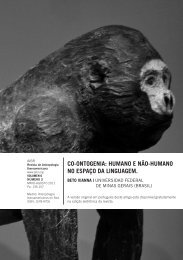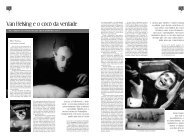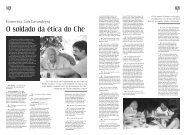Merleau-Ponty, 1964. Eye and mind. - Biolinguagem
Merleau-Ponty, 1964. Eye and mind. - Biolinguagem
Merleau-Ponty, 1964. Eye and mind. - Biolinguagem
- No tags were found...
You also want an ePaper? Increase the reach of your titles
YUMPU automatically turns print PDFs into web optimized ePapers that Google loves.
draws my flesh into the outer world, <strong>and</strong> at the same time the invisible of my body can<br />
invest its psychic energy in the other bodies I see. 13 Hence my body can include<br />
elements drawn from the body of another, just as my substance passes into them; man is<br />
a mirror for man. Mirrors are instruments of a universal magic that converts things into<br />
spectacle, spectacle into things, myself into another, <strong>and</strong> another into myself. Artists have<br />
often mused upon mirrors because beneath this "mechanical trick," they recognized, as<br />
they did in the case of the "trick" of perspective, 14 the metamorphosis of seeing <strong>and</strong> seen<br />
that defines both our flesh <strong>and</strong> the painter's vocation. This explains why they have so<br />
often chosen to draw themselves in the act of painting (they still do—witness Matisse's<br />
drawings), adding to what they could see of things at that moment, what things could see<br />
of them—as if to attest to there being a total or absolute vision, leaving nothing outside,<br />
including themselves. Where in the realm of the underst<strong>and</strong>ing can we place these occult<br />
operations, together with the potions <strong>and</strong> idols they concoct What can we call them<br />
Consider, as Sartre did in Nausea, the smile of a long-dead monarch which keeps<br />
producing <strong>and</strong> reproducing itself on the surface of a canvas. It is too little to say that it is<br />
there as an image or essence; it is there as itself, as that which was always most alive<br />
about it, the moment I look at the painting. The "world's instant" that Cézanne wanted to<br />
paint, an instant long since passed away, is still hurled toward us by his paintings. 15 His<br />
Mont. Sainte-Victoire is made <strong>and</strong> remade from one end of the world to the other in a way<br />
different from but no less energetic than in the hard rock above Aix. Essence <strong>and</strong><br />
existence, imaginary <strong>and</strong> real, visible <strong>and</strong> invisible—painting scrambles all our<br />
categories, spreading out before us its oneiric universe of carnal essences, actualized<br />
resemblances, mute meanings.<br />
III<br />
How crystal clear everything would be in our philosophy if only we would exorcise these<br />
specters, make illusions or objectless perceptions out of them, brush them to one side of<br />
an unequivocal world!<br />
Descartes's Dioptrics is an attempt to do just that. It is the breviary of a thought that<br />
wants no longer to abide in the visible <strong>and</strong> so decides to reconstruct it according to a<br />
model-in-thought. It is worthwhile to remember this attempt <strong>and</strong> its failure.<br />
Here there is no concern to cling to vision. The problem is to know "how it happens," but<br />
only enough to invent, whenever the need arises, certain "artificial organs" which correct<br />
it. 16 We are to reason not so much upon the light we see as upon the light which, from<br />
outside, enters our eyes <strong>and</strong> regulates our vision. And for that we are to rely upon "two or<br />
three comparisons which help us to conceive it [light]" in such a way as to explain its<br />
known properties <strong>and</strong> to deduce others. 17 The question being so formulated, it is best to<br />
think of light as an action by contact—not unlike the action of things upon the blind man's<br />
cane. The blind, says Descartes, "see with their h<strong>and</strong>s." 18 The Cartesian model of vision<br />
is modeled after the sense of touch.<br />
At one swoop, then, Descartes eliminates action at a distance <strong>and</strong> relieves us of that<br />
ubiquity which is the whole problem of vision (as well as its peculiar virtue). Why should<br />
we henceforth puzzle over reflections <strong>and</strong> mirrors These unreal duplications are a class<br />
of things; they are real effects like a ball bouncing back. If the reflection resembles the<br />
thing itself, it is because this reflection acts upon the eyes more or less as a thing would.<br />
It deceives the eye by engendering a perception which has no object, yet this perception<br />
does not affect our conception of the world. In the world there is the thing itself, <strong>and</strong><br />
outside this thing itself there is that other thing which is only reflected light rays <strong>and</strong> which<br />
happens to have an ordered correspondence with the real thing; there are two<br />
7









